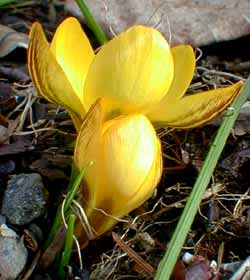
'Fuscotinctus'
Gold Crocus
"See the crocus' golden cup
Like a warrior leaping up."
-Joseph Mary Plunkett
(1879-1916)
(1879-1916)
Under the young Pin Oak with full morning sun & dappled afternoon sun, I planted a small patch of Gold Crocus (C. chrysanthus var. fuscotinctus). They were mixed in with autumn-blooming Saffron Crocus (C. sativas), because I was thinking it would be great to have crocuses appear in that spot in two seasons. In their second year I lifted to move the saffrons to a much sunnier location by the road, & some of the 'Fuscotinctus' corms got moved along with them more or less accidentally. So now there are just a few of them that bloom in both locations. The photo shows one out by the road in early February 2004.
'Fuscotinctus' begins opening its buds the last week of January & is in full flourish through February, usually gone by the first week in March. In colder zones they'll be a couple weeks later & lingering into March. They are bright yellow with violet streaks on the outside.
Elsewhere, under White Icicle Flowering Currant, there's a larger drift of crocuses that look almost exactly like 'Fuscotinctus,' but they are 'Gypsy Girl,' which has been many times swifter to spread year after year. 'Fuscotinctus' never took off in either location, compared to several other yellow crocuses we have which are nothing short of spectacular.
The 'Fuscotinctus' has taller thready leaves to eight or ten inches, with small yellow flowers nestled close to the ground amidst the leaves. Occasionally an early bloom appears ahead of the leaves but usually the leaves arrive first. By comparison, 'Gypsy Girl' has much shorter grass to four inches, & larger showier intensely golden flowers.
Planted in drifts in Autumn in full sun to partial shade, both 'Fuscotinctus' & 'Gypsy Girl' are among the earliest crocuses to bloom, getting well ahead of Spring. 'Gypsy Girl' begins blooming a week earlier than 'Fuscotinctus.' Appearing a couple weeks later than 'Fuscotinctus' is another very similar magenta-feathered yellow called 'Goldilocks,' which has likewise spread like crazy, though it's also been in the ground more years.
A species variant rather than a cultivar or hybrid, 'Fuscotinctus' has been in gardens for a century. It remains the standard by which other yellow crocuses are compared, & I remember when we first got the bulbs I greatly looked forward to having such a well-famed & pure botanical. The fact that after only two years I disrupted 'Fuscotinctus' because I had to move the fast-reproducing saffrons did not help the situation, but the disappointing fact remains that every other crocus we ever planted produced impressive drifts instantly, thicker every year. Hardy down to zone three our four, in our mild Zone 8 'Fuscotinctus' should have naturalized with swift ease & become a heavier drift each year, but in three years only blooms tepidly.
I'm almost tempted to plant more of them in a potentially better location, just to see if they would be more impressive from another source, as my experience with just these few bulbs is that they are moderate performers compared to all other yellows. But I suppose they are too similar to the massively flowery 'Gypsy Girl' both for bloom-time & appearance to bother planting more 'Fuscotinctus,' which I still hope will eventually make a grander showing.